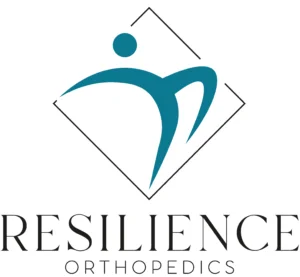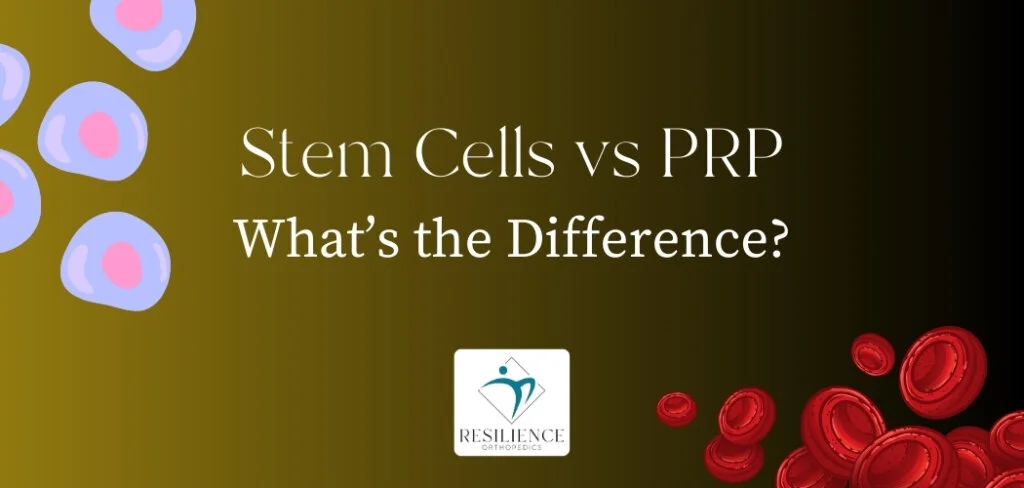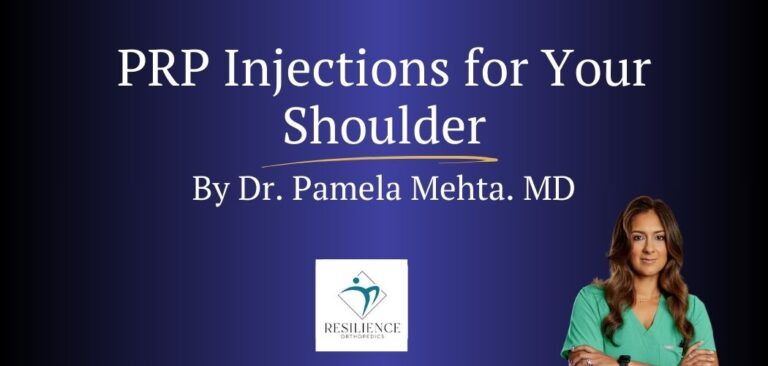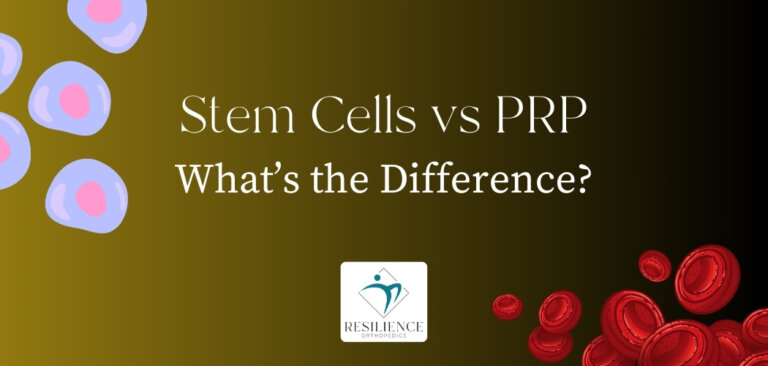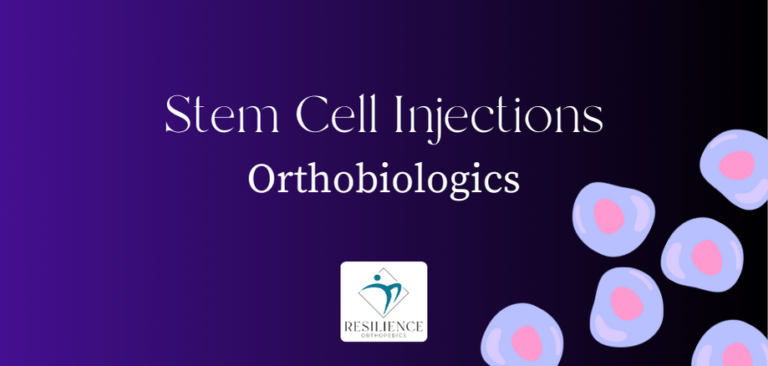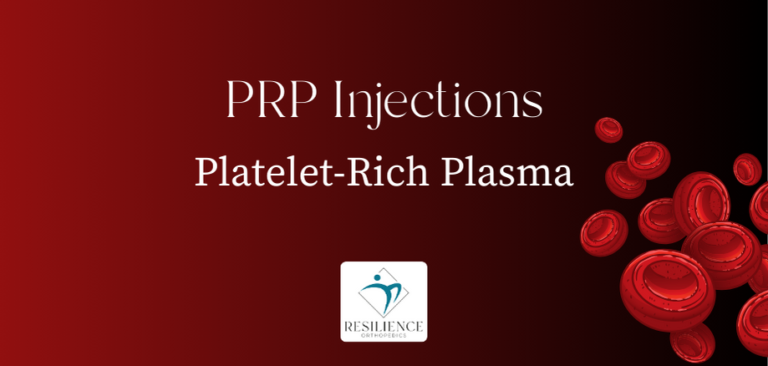Table of Contents
About PRP & Stem Cell Injections
Both PRP and Stem Cell Injections are types of cutting-edge regenerative medicine therapies. When we use these to help joint and muscle conditions, we call them orthobiologics.
Orthobiologics are treatments that help with conditions like osteoarthritis, and cartilage injuries. They can even be useful if you have a bone fracture. Different therapies form part of orthobiologics, including these two types of treatment.
When you compare PRP vs stem cell injections, it’s important to know exactly how they differ – and when each of these treatments is helpful.
In this article we’ll go through:
- Benefits of both PRP and Stem Cells
- How they both work
- What conditions benefit from which therapy
- The difference in cost
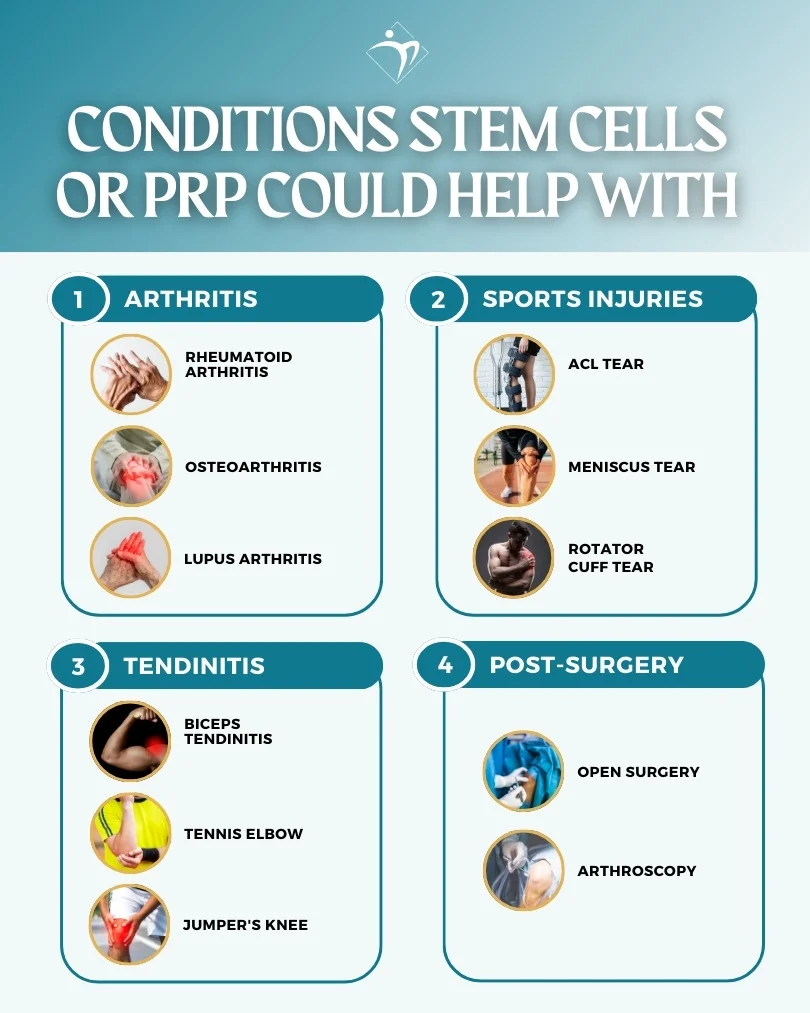
About PRP
PRP, also known as platelet-rich plasma, is a treatment that uses your own blood to extract platelets. Then, these platelets are “concentrated”, and finally injected back into your body – specifically in the area where you have damage.
Since platelets are rich in growth factors, they actually promote your body’s natural healing capabilities. This also happens naturally when you’re injured, as blood clots and growth factors help to get the repair process started. However, PRP enhances this entire process and may help speed up recovery from injury or joint conditions.
About Stem Cells
Stem cell therapies can be thought of as requiring more advanced technology compared to PRP. However, you might notice that it offers benefits that are similar to those you see with PRP.
With stem cell therapy, the goal is to introduce undifferentiated cells into your body. These cells are “blank” – they don’t have a specific purpose yet. But, they can create daughter cells that are differentiated, or specialized.
By injecting these cells into areas that are low on natural reserves of stem cells, we can supply them with new healthy cells. In essence, these cells can help your joint and soft tissue regenerate and add new healthy tissue.
The Difference
The headline difference between these two therapies is that they are made of different things. PRP comes from blood plasma, whereas stem cells can come from places such as blood, bone marrow, and fat cells.
Platelet-rich plasma uses a blood sample that’s collected from you, the patient, whereas stem cells can sometimes come from a donor.
Platelets function to help promote healing and repair. It’s also important to understand that, in PRP therapy, the platelets aren’t cells that can replace damaged cells in your own body. The idea behind PRP is to give the damaged area a boost.
In stem cell therapy, however, these cells can directly replace cells you’ve lost through wear and tear. This is useful if your joint has lost the ability to replace its damaged tissue. Platelets might not have as much effect in this case, whereas stem cells may provide a new lease on life for these joints.
Book a Consultation with Dr. Pamela Mehta, MD
The Best Orthopedic Surgeon in San Jose
Dr. Mehta is a board-certified orthopedic surgeon who can help you recover from your joint condition. If you:
- Are Suffering From Pain and Mobility Issues
- Need Orthopedic Assessment and Advice
- Want Treatment From a Top Orthopedic Doctor
We Can Help
How Do They Work Differently?
PRP is a relatively quick therapy, as platelets can easily be retrieved from a blood sample. However, stem cells need to be collected and grown in a laboratory. They require very specific environments to grow before they can be considered therapeutic (ready to be used for treatment).
However, platelet-rich plasma has limitations in that it can only provide healing properties for cells that are present in the sample. With stem cells, you get the “primitive” cell that can create an estimated 200 different cells.
PRP works by providing a boost in healing and growth factors to the affected area. Stem cell therapy works by giving the “building blocks” needed to grow new tissue. Therefore, these therapies will have different effects based on:
- The location of the soft tissue or joint damage
- The type of condition we are treating
- The severity of your condition
- How much wear and tear is present
To truly understand the differences, let’s look at a scientific paper on the topic. The paper focuses on understanding the differences that exist between platelet-rich plasma and stem cell therapies, as regenerative medicines.
The paper describes the fact that some patients are told to opt for PRP therapy because it “does the same job”. However, the paper explains that this is not entirely true – platelet-rich plasma and stem cell therapy both offer different opportunities to increase growth factors.
Now, it’s important to note that the paper doesn’t call PRP an ineffective treatment option. It mostly focuses on the fact that they work differently and that even the preparation methods for each are completely different.
Let’s look at what each treatment is better at:
Pros and Cons of Both Treatments
One treatment isn’t necessarily superior to the other, as this is a question that requires you to actually assess the situation.
However, there are a couple of ways to differentiate between the two – specifically if you’re looking to understand the PRP vs stem cell injection comparison.
Pros & Cons of PRP:
Pros
- Cost. PRP is generally considered the more affordable choice. It’s a simpler procedure compared to stem cell therapy.
- Complexity. PRP is also a less complex procedure than stem cell therapy. This means the process might require as much time.
- Complications. As the plasma injected in PRP comes from your own body, there’s no concern about your body’s immune reaction to the injection.
Cons
- Longevity. With PRP injections, you may start to notice that your symptoms recur after six to 12 months. This means you’ll likely need to go for a follow-up injection.
- Effectiveness. When you’re comparing stem cell versus PRP, it’s important to note that both are effective. However, things like the severity of a condition and how the procedure is performed can actually affect the efficacy. PRP is mostly a good solution for milder cases.
Pros & Cons of Stem Cells:
Pros
- Longevity: Stem cell therapies are better when it comes to the longevity of the treatment results. When you opt for stem cell therapy, it’s an option that has longer-lasting results.
- Efficacy: Stem cells will have a better effect for certain conditions. In situations where the damage is severe, you might want to consider stem cell therapy instead.
Cons
- Cost: Stem cell treatment is a slightly more complex procedure compared to PRP, meaning it will probably cost a little more. This has to be weighed against how effective and long-lasting it is likely to be.
- Evidence. Stem cell therapy is a newer treatment and has wider-ranging treatment options. This means there is less specific evidence on using stem cells in orthobiologics. Despite this, there is more research happening with stem cell therapy in general.

Which Treatment is a Better Option for Me?
Both of these treatments can help to increase growth factors at the site of injury. So, how do you know which treatment is ideal for you?
The truth is, there isn’t a “generic” answer to this question. Whether you decide to opt for PRP or stem cell injections, it’s important that you fully understand all of your options. How severe the damage is will have a big impact on which treatment is right for you.
To ensure you make an informed decision, discuss this with your doctor. Speak to them about the severity of the condition and ask for their opinion on which therapy will be most suitable for you.
They can make suggestions and talk to you about the reasons for these – allowing you to better understand why a certain therapy might be better for you in particular.
PRP Injection
One research paper explains that platelet-rich plasma injections do hold potential for patients who have osteoarthritis. This study found that the treatment is most effective in cases of mild to moderate levels of osteoarthritis. Those who were treated with PRP showed improvements in stiffness, pain, and joint function.
However, there are cases where the therapy doesn’t offer as effective results. Another clinical study found that while PRP does help with most forms of the disease, these results were not seen in patients with hip osteoarthritis.
Thus, there are cases where PRP is not the ideal choice. If this is the scenario, then turning to stem cell therapy might be the better choice.
Research is still ongoing, so more developments are to be expected in the future.
Stem Cell Injection
Stem cell therapy is often suggested in cases where you have more severe injury to your tissues.
In cases of more advanced osteoarthritis, the use of stem cells can help to replace cells that were damaged. This is something that the use of platelets to increase growth factors might not be able to do. That’s because PRP therapy focuses on repairing damaged cells, but sometimes the damage is too advanced.
There are also different opportunities available when it comes to stem cell therapy. For example, mesenchymal stem cells seem to be some of the most efficient options for patients who have osteoarthritis. These stem cells can differentiate into specific cells that are present in areas like cartilage.
As stem cells are a more complex area, it’s best to discuss with your doctor whether they are a good option.

PRP vs Stem Cell Injections for Knees
Injuries and conditions affecting the knees are quite common – after all, your knees provide support for the weight of your upper body. Research suggests that among those 40 or older, about 22.9% have knee osteoarthritis. This doesn’t even account for other knee problems.
When it comes to comparing PRP vs stem cell injections for knee conditions, consider the condition we’re treating and how severe it is.
As more research emerges, we’ll know more about the use of stem cells in conditions such as:
Ready to Recover?
Take the first step in getting back to your normal self, and book an appointment with Dr. Mehta today.
We’re ready when you are!
With the limited evidence we have now, we know that PRP might be suitable for milder or moderate cases of osteoarthritis. The aim is to reduce progression and to reduce the need for future knee replacement or other knee surgeries.
In cases of more severe osteoarthritis or damage to the cartilage, joints, and ligaments in your knee, you may want to consider stem cells. Stem cells may be more efficient as they can replace damaged cells in these tissues.
Ultimately, it comes down to the experience and advice of your knee surgeon, and what your priorities are for treatment.

PRP vs Stem Cell Cost
The cost of any treatments is a consideration you must make when planning your doctors visits. This is especially true for PRP and stem cells, as insurance doesn’t often cover these procedures.
There are a couple of things that you have to take into consideration when talking about the cost. For example, the procedure itself has a price, but don’t forget to account for the price of:
- The initial consultation
- Investigations
- Laboratory fees
- Follow-up appointments
Pricing for PRP is generally more affordable compared to stem cell therapy. We use your own blood plasma as part of this procedure. Therefore, you won’t need to be billed for additional medications or formulations.
Stem cell treatments are usually more complex than PRP. We may also require a donor if your own stem cells can’t be used for the procedure. The cost depends on the type of stem cells that would work best for your condition or injury.
To get a better idea of the price of treatment, get in touch with us today. Dr. Mehta will gladly talk you through the various treatment options and can give you an idea of the potential cost.
